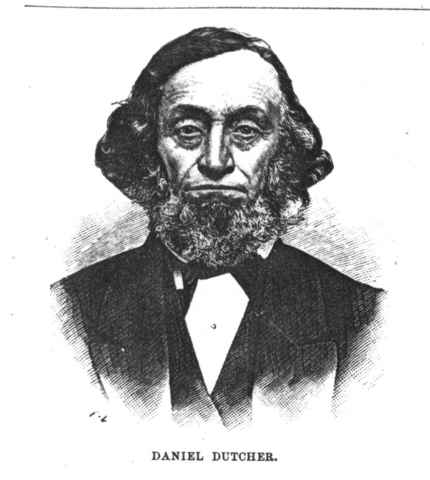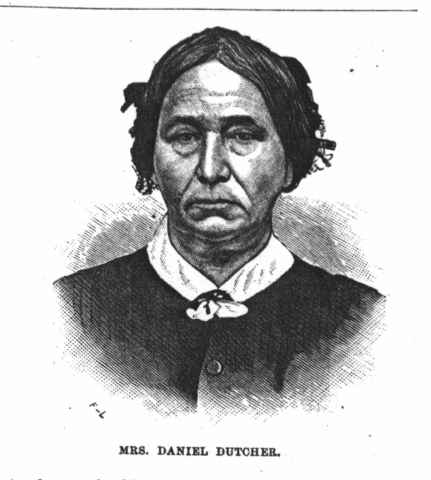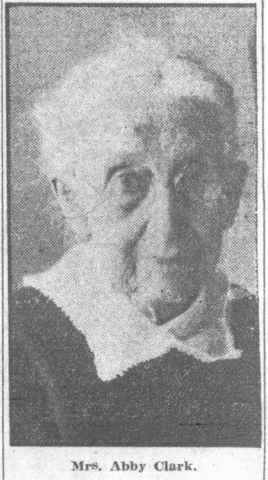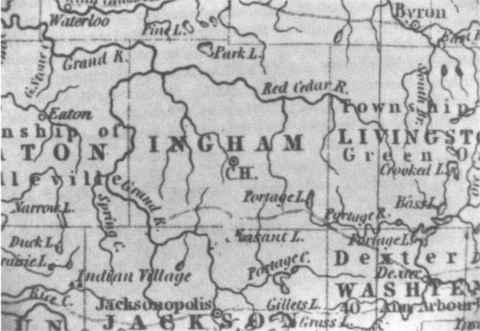History of Ingham County, Michigan
Mr. & Mrs. Daniel Dutcher, grandparents to Mr. & Mrs. Lucius & Electa Bushnell


Daniel Dutcher was born Sept. 1, 1805, in the town of Oppenheim, Fulton
Co., N.Y., being the third child in a family of seven sons and three
daughters. At an early age he was instructed in all that pertains to
farming, receiving also a common-school education. By mutual consent of
his parents, when nineteen years of age he went forth from home to
build up his own fortune. He first found his way to Yates, Orleans Co.,
N.Y. The change was disastrous to his health, bringing on a sickness
that lasted twenty-three months and exhausted his small capital.
Nothing daunted, without money for a trousseau by either of the
contracting parties, on April 13, 1825, he married Miss Maria Bullock.
At farm work by day, and occasionally jobbing, he managed to make a
comfortable living. About a year after their marriage he purchased a
piece of land from the Holland Company. Each year his balance-sheet
showed a small gain, and in May, 1835, on closing out his interest, the
sum of fifteen hundred dollars appeared to his credit.
Leaving his family he journeyed West to secure a home, and after an
extended search located three hundred and twenty acres on section 2,
Stockbridge, and sections 34 and 35, White Oak, this being the first
entry of land in the latter township.
He returned home in June, and in September following they come by canal
to Buffalo, by lake to Detroit, and there purchased a yoke of oxen and
wagon, into shich he loaded his household goods and family. His
purchase of a team proved rather unfortunate, as they were wild and
intractable. He was obliged to walk by their side the entire distance,
quite an inconvenience, as at times the road was only cleared
sufficient to permit the passage of a wagon.
Each day's journey seemed the hardest, until the climax was reached the
last day's drive, about noon, when he landed his outfit into a marsh so
deep that it could not by extricated without assistance. He bethought
him of a man they had passed about three miles back, and, after
securing his team, went to abtain help. He could not spare the time
until after his day's work was finished. To remain out all night was
impossible. Returning, he and his wife each took a child in their arms,
and, leading the third one, journeyed on foot a distance of seven miles
to her brother's, then residing in Unadilla.
Leaving his family he went forward and erected a log house twenty by
twenty on section 35, White Oak township, to which he removed his
family the October following, this constituting the first settlement in
that township. From the wilderness home he brought forth one of the
finest farms in Ingham County, and during his ownership conducted it on
the most extensive scale.
After his large family had grown to maturity and passed from the
parental roof, he sold and distributed sixteen thousand dollars abong
them, and retired to a farm of forty acres. So accustomed to labor, and
with a mind so active, he could not remain idle.
They were the parents of eleven children, as follows: Mrs. Elizabeth
Youngs, born Jan. 16, 1828, resided at Williamston; Benonia, born Nov.
22, 1829, died at the age of nine months; Daniel T., born Oct. 17,
1831; Joseph A., born June 3, 1834, now of Fairfield, Shiawassee Co.;
Mrs. Abbie Clark, born Dec. 19, 1835; Stephen, born Nov. 8, 1837, died
from disease contracted in the army; Israel, born Oct. 19, 1839, died
Dec. 27, 1862; Mary M., born Oct. 31, 1841; Mrs. Patience Van Buren,
born June 2, 1843; Mrs. Olive Van Buren, born May 30, 1845, now of
Stockbridge; Mrs. Victoria Carpenter, born Nov. 3, 1847.
While they were yet in their youth, Mr. and Mrs. Dutcher joined the
followers of the Christian faith, and after a united labor of
forty-five years, on May 7, 1874, Mrs. Dutcher passed to the fullness
of that reward to those who faithfully follow the teachings of the
Master, beloved by all for her many womanly qualities and her untiring
devotion to her family. Mr. Dutcher continues on in the fullness of
years, honored and respected for his many noble qualities, firm in the
Christian faith that shall unite him with those gone before.
 News of Death of First White Child Born in Ingham Co. Comes
News of Death of First White Child Born in Ingham Co. Comes
Belated news of the death of Mrs. Abby Clark, who was the first white
child born in Ingham county, comes through public announcement of her
death at the meeting of pioneers at Mason, this week.
Mrs. Clark, who had resided for some time at the home of her son, Will
G. Clark, 116 S. Francis st., this spring, went to her old home in
Stockbridge and then to the home of her daughter in Fowlerville. It was
while there that she died. The end came May 3. The body was interred at
Stockbridge.
Mrs. Clark was the daughter of Mr. and Mrs. Daniel Dutcher. They
settled in this county in the fall of 1835. In December Abby was born
in their cabin home on the southern edge of what is now White Oak
township, near Lowe Lake. The wagon in which the Dutcher's made their
advent in this county had come most all the way through the wilderness,
without a suggestion of a road.
In the midst of hardships, in the sound of howling wolves, and in
childhood fear of Indians, Abby Dutcher grew to young womanhood. At 19
she married George Wilson, a young carpenter, who came to aid in
framing her father's first frame house. Young Wilson was an ardent
abolitionist and so he threw down his hammer to answer the call of
Lincoln for defenders of the Union. Death claimed this ardent young
patriot in the service. Later, the widow married Elias Clark, and they
lived long together, most of the time at Stockbridge.
The pioneer experiences of Mrs. Clark were told in considerable detail
in The State Journal early this spring, she having been interviewed at
the home of her son, Will G. Clark, at that time, Mrs. Clark was then a
frail little wisp of a woman, but her mind and her sensibilities were
keen to the memories of long ago. Beyond question she was the first
white child born in the county.
Abby & Elias Clark's daughter's Bushnell lineage: Francis #1,
Richard #10, Joseph #44, Nathan #88, Nathan #193, Aaron #399, Tracy
#920, Harvey #1974, Lucius #3332 m. Electa Clark.
...A BUSY LIFE ENDED...
With the Passing of ELIAS S. CLARK Stockbridge Loses One of Her Most Progressive Men
Elias S. Clark was born July 12, 1832 and departed this life July 18, 1902, aged 70 years and 6 days.
Mr. Clark was born in Ontario County, New York, where he continued to
reside until he was 4 years of age; his parents then moved to the
vicinity of Tecumseh, where he continued to reside for some time. In
1852, he was united in marriage to Miss Sarah Haney. Six children were
born to them; namely, John Carel Clark, Mrs, Janey O'Hara of Clinton,
Mrs. Mary Parker, Samuel and Ambrose Clark, and one who died in infancy.
When the discovery of gold in California was made known, he at once had
strong desire to seek his fortune in these new fields of wealth and in
the fall of 1856, we find him leaving home and loved ones for
Sacramento Valley, California. He coasted along the eastern shore as
far as the Gulf of Mexico, across the Isthmus of Panama, visiting
enroute many of the historical cities and ruins that lay in the pathway
he travelled and then coasted north along the Pacific. He spent four
years in the gold fields, making his headquarters at Grass Valley. On
returning home in 1860, he moved to White Oak, where he built for
himself a log workshop and followed the business of millwright.
In April, 1864, he was called to pass through sorrow by the death of
his wife. September 25, he was remarried to Mrs. Abbey Wilson and down
the pathway of life they journeyed together in loving union. Three
children were born to them, namely, MRS. ELECTA BUSHNELL of Fleming,
Will G. of Millville, and Lon E. of Stockbridge.
He always took active interest in the life and welfare of the township
in which he lived. During the Civil War, he was one who raised the
money to exempt the township from draft. During his residence at White
Oak, he built a saw mill, grist mill and a store, besides clearing part
of 40 acres and later, buying 160 acres, 100 of which he cleared. The
store was destroyed in 1882, and in 1884, he moved to Stockbridge and
built the mill by the fair ground, moving his machinery from White Oak.
He built for his first home in Stockbridge, the house where John Frey
now resides.
That enterprise and activity which marked his life and for which he was
so well known, materialized in his building the brick mill where he had
done business and resided for many years. In 1896, he came into
possession of the Rogers property, where he plotted and opened up three
streets and built two residences, besides making other improvements. He
built the home of his son, Lon, and the building now occupied by the
Crystal Laundry.
The crowning enterprise of his life was in the new and commodious mill
almost completed. Part of the machinery was in position, but the
workman was called away amidst the unfinished plan and hopes of life.
In November of 1901 he met with an accident to his left foot which
necessitated the amputation of one toe. He suffered much, but with
patience and medical skill, he had almost fully recovered, when on the
morning of July 9, he was taken with heart failure and in the evening
suffered a stroke of paralysis. He was watched over and cared for by
his devoted and loving wife and dear children, who ministered to his
every need, but death gave its fatal blow and the life held dear by
wife and children past beyond.
He will be missed in the home and in the mill and the community. He was
widely known and was a member of the Stockbridge Lodge No. 183 F. &
A. M.
The above article is a reprint of the Obituary Published in the Stockbridge Community Newspaper about July 20th, 1902.
Twenty-Two Buildings Erected
Structural Enterprises of the late Elias S. Clark
When it is remembered that by occupation Mr. Clark was not a
contractor, -that building was his avocation and milling his vocation;
his record will go down in the annals of Stockbridge as one of the most
unique.
Observe the following list:
In the Year:
1851 ... A house for a Mr. Keeder in Tecumseh.
1852 ... A house for another man in Tecumseh by the name of Addie.
1852 ... A home for himself and family in Tecumseh.
1855 ... A sawmill in Mason, where he fell victim to a broken leg while engaged in the project.
In 1856 during the Gold Rush he travelled to California in search of
his fortune, but returned to look for the diamonds which might be
discovered in his own backyard during the year of 1860. Moved to White
Oak township.
1860 ... Built a log mill and worked as a carpenter & millwright.
1861 ... Assisted in the building of a Stave mill for a Mr. Topping at Plainfield.
Also had a hand in building what is known as the Pulling Mill in White Oak township.
1862 ... A house for himself in the settlement of Millville an
important segment of White Oak Township. The present residence of his
son William Clark & family.
1864 ... A house for a man named VanBuren in White Oak.
1875 ... A Grist Mill in the same township.
1882 ... A store which was destroyed by fire.
1883 ... Another store in White Oak, now known as the Anderson store.
1884 ... Again a new house for himself in Stockbridge, where John Frey now resides.
1884 ... The Flourmill near the fairgrounds.
1886 ... Another new Grist Mill in Stockbridge.
1897 ... Lon Clark, his son's house near Unadilla.
1899 ... The Checkered Front Laundry building in Stockbridge.
1900 ... A house now owned by Mrs. Doolittle.
1900 ... The house where Mrs. Harlow resides.
1900 ... Built a barn for himself.
1901 ... The Crystal Laundry.
1901 ... A new Machine Shop & Mill together with a Bakery Store.
The above is a copy of that which appeared in the Stockbridge Sun
Newspaper at the time of Mr. Clark's death back on July 18th, 1902.
Saved by his grand-daughter Ada E. Baker, the mother of Edward E.
Parker, historian & genealogist.
 1835 Map of Ingham County
1835 Map of Ingham County
PIONEER MEMORIES: The story of the first white child to be born in
Ingham County is as interesting today as it was in previous years as we
live again the hardships and privations, and appreciate the patience
and frugality of the Daniel Dutcher family.
Let us journey back into the roadless woods of Ingham County, 140 years
ago, and watch the coming of the early pioneers to our country. The
immigrant wagon of Daniel Dutcher creaked to a standstill, broken under
the strain of traveling the Michigan wilderness.
Hear the patient oxen, the breath issuing almost resonantly from their
tense nostrils. How small and inconsequential the few human voices now
raised seem in that nearly silence-clogged wilderness as they counsel
what to do. The breakdown is decisive and there is little need to talk.
The Dutchers must go on through the trackless woods.
The young mother climbs down from the wagon and taking one child by the
hand she is heavy with the soon-to-be first white child born in Ingham
County. The father carries the youngest child. The family goes forward.
Night is fast closing down, but the Dutchers make their way on through
the dark. A simple little procession, to the undiscerning, but it is
tremendous in its impact when considered as the beginnings of a new
civilization.
Persistence on the part of the travelers took them eventually to the
cabin home of Mrs. Dutcher's parents, already established for a year in
what is now Unadilla of Washtenaw County. But that was only a stopping
place. The next day the wagon was repaired and in a few days on they
went, into the forest that one day was to become Ingham County.
Eventually Daniel Dutcher and his little family came to a halt on the
white oak land at the southern edge of what is now White Oak Township,
just over the line from Stockbridge Township, near Lowe Lake. That was
in the fall. On December 19, 1835 Abby Dutcher, later to become Mrs.
Elias Clark of 116 S. Francis Street, Lansing, was born. With this
domestic event Ingham County had begun. The first white child had been
born within its boundaries.
Hearing today the story of the beginnings of the Dutcher family, in
their little clearing, made on the government land, claim to which had
been taken at "ten shillings an acre," one is forced to believe that
they had no more vision of the wonderful country they were building,
than Moses had when he tended the flocks of Jethro. In their simplicity
they wrought better than they knew.
When Daniel Dutcher and his family arrived on their claim in the early
fall, the had nothing but fast disappearing supplies in their wagon.
These they had purchased at Detroit after they had come up the lake
from York State. They had $1,500 when the started; they were risking it
all on their great venture. But it was more-much more-than a gambler's
choice. Their whole capital was invested in an opportunity of hard work.
When Abby was born in December, the first rude cabin was already up. It
had no doors or windows. Across one side of the cabin extended a wide
fireplace above which rose a chimney of mud and sticks. Before the
Dutcher's first candles were made, brush piled high on the big backlog
supplied the only light for the cabin.
Everything was strange and new. The pioneer made circumstances bend to
his will instead of bending to circumstances. The pioneer housewife was
tenacious almost to a fault of things her mother had taught her.
It was almost no time at all before white bread was made and somehow or
other the pioneers managed very early to see to it that cows came to
the frontier. Milk they would have.
Mrs. Clark remembered setting out a huge loaf of bread and a pan of
milk for some hungry Indians, one day when her parents were away. "We
threw the remains of the food away," Mrs. Clark related, from which one
may gather that Indians impressed children in those days, as being, as
we would say today, "unsanitary."
That the pioneers had it in them not to sink to the level of conditions
as they found them, but were willing to battle for their standards of
life, is instanced in the fact that they would travel back to Detroit
for white flour.
The big round loaves of bread in those days were baked in a "bake
kettle," a long extinct contrivance that used to be buried in coals
raked from the fireplace. The cover had a rim or collar to keep the hot
coals atop the kettle.
Preceding the Dutcher family was the Lowe family of which Heman Lowe
was the head. Both families were on the actual frontier of Michigan.
Mrs. Clark said that as far as they knew there were no white people
beyond them in the wilderness. The beginnings of Lansing had not been
made. The sawmill at "Northtown" was not yet up.
One of the terrors of Mrs. Clark's young life was the wolves. This
terror, she said, was shared by her mother. Nearly every night before
the family could sleep, the wolves had to be frightened away with
burning brands from the fireplace. The Indians never gave them much
trouble even though quite a good many of them lived nearby. An Indian
trail was the only pathway the Dutchers and their neighbors knew. Lowe
Lake was a popular Indian site.
How strikingly those old timers took to the ways of civil government.
Almost before their cabins were built they planned a township and
county government. The Dutchers settled just north of Stockbridge
Township in 1835. The next year Stockbridge was organized as a
township. White Oak itself, was made a township only four years after
its first settlers arrived.
"I tell you there wasn't a lazy hair in anyone's head in those days,"
Mrs. Clark said. "We all worked as hard as we could, and we had some
terrible times -yes, indeed we did - but we were all as happy as folks
are now days and I don't know but happier."
For several years Mrs. Clark possessed the spinning wheel which was a
prime necessity in her frontier home. She not only learned to spin, but
she made cloth as well. She remembered with pride how she made her
first husband a full suit of clothes of black satinette.
"Our men folks looked just as well as they do now though we made their
clothes from the cloth we had made from wool off our sheep's backs,"
Mrs. Clark stated, although modern tailors might not agree with her.
When Mrs. Clark was asked how women's dresses were made, she replied:
"Well, they wasn't as short as they are now, that's one thing!"
She remembered the wedding dress she wore when she was a bride of 19.
It was a dark wool delain, with a small white figure. George Wilson and
Abby Dutcher met when the young man came to help build the new Dutcher
frame house, which when finished was considered quite a mansion. She
admitted that she and young Wilson, her first husband, did not have
much of a wedding. They drove to Howell in Livingston County, were
married there and then, for a honeymoon spent a week in Livingston with
relatives. When they were coming home the snow was so deep and badly
drifted that their sleigh overturned.
And so those young people were married trusting the future as
implicitly as it had been trusted in all ages. Little did they realize
that the great Civil War was coming. But come it did and it took the
life of the young abolitionist husband who declared the slaves ought to
be free even if it meant war.
"I would rather enlist and be killed than drafted and escape," he declared.
He was a member of Company H., 26th Regiment. The scarred battle flag
of the company may still be seen in the capitol rotunda in Lansing.
Those were grave, dark days that brought tears and sorrow as Mrs. Clark remembered.
It was through her widow's pension that she was able to take her first
trip to Detroit. She went by stage from Stockbridge to Dexter and from
there to Detroit by rail. It was the first time she had ever seen a
train.
There is a wealth more to tell of Mrs. Clark's experiences. She came to
Lansing to see the old capitol after it had been completed. She never
returned to the big city until she came back to live with her son.
One circumstance, however, fully characteristic of the times and very feminine should be told.
Hoop skirts had become fashionable at about the beginning of the Civil
War. The young Mrs. Wilson had to have one but thrift was written in
capital letters in those days. She improvised to meet the style by
sewing wild grape vines inside her skirt.
After her second marriage to Elias Clark, the two of them lived and
prospered for a long time in the village of Stockbridge.
Indeed, there seemed to be few people who had so fully and
characteristically contributed to the raising of Michigan from a
wilderness to what it is today as the pioneer woman, Abby Dutcher
Wilson Clark.
Abigail "Abby" Dutcher was my great grand-mother and a heroine
to all of us because she was born in a
log cabin just a few miles from where we all live. As the item says,
she was the first settler baby born in these parts. One of her
daughters, Electa, married Lucius Edward Bushnell, #3332, and they had
nine children including Keith's dad, Elno #4610, and my dad, Claudius
#4607.
Abby was once in a parade that featured 5 generations. We wanted to
share this with you. The fact that fear of howling wolf packs kept them
in the cabin at night, tells me all I need to know about the wisdom of
re-planting wolfs near people.
-Herm Bushnell #5427, MI





